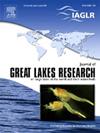A bellwether for microplastic in wetland catchments in the Great Lakes region
IF 2.5
3区 环境科学与生态学
Q3 ENVIRONMENTAL SCIENCES
引用次数: 0
Abstract
This study is intended as a bellwether for the occurrence of microplastics (MPs) in Great Lakes wetlands. In 2020, sediment, surface water, and atmospheric deposition samples were collected from wetland catchments in or near five National Wildlife Refuges (NWRs) in the Great Lakes region: Horicon-WI, Seney-MI, Shiawassee-MI, Ottawa-OH, and Montezuma-NY. Sediment and surface water samples were taken from river, stream, and canal inflows and outflows to and from wetland areas. Atmospheric deposition samples were collected in carboys placed near established rain gauges. These sample sites were chosen as indicators of MP deposition into and out of the region’s wetland systems. MPs (100 μm–4 mm surface water samples; 63 μm–4 mm sediment and atmospheric deposition samples) were extracted from each sample, enumerated, and categorized by particle morphology and polymer type. Average MP particle abundances in the sediment and surface water samples ranged from 344 to 538 particles kg−1 (dry weight) and 2–68 particles m−3, respectively. Atmospheric MP deposition ranged from 5.8 to 22.6 particles m−2 d−1. Fibers were the most abundant MP particle type found in each sample type (sediment, surface water, and atmospheric deposition), followed by fragments. These results suggest that input and retention of MPs are pervasive in the Great Lakes region and surrounding wetland areas.
大湖区湿地集水区微塑料的风向标
这项研究旨在为五大湖湿地中微塑料 (MP) 的出现提供一个风向标。2020 年,从五大湖区的五个国家野生动物保护区 (NWR) 内或附近的湿地集水区收集了沉积物、地表水和大气沉积物样本:五大湖区的五个国家野生动物保护区 (NWR) 内或附近的湿地集水区采集了沉积物和地表水以及大气沉积物样本。沉积物和地表水样本取自流入和流出湿地地区的河流、溪流和运河。大气沉积物样本收集于放置在既定雨量计附近的容器中。这些取样点被选为进入和流出该地区湿地系统的 MP 沉积指标。从每个样本中提取 MP(100 μm-4 mm 地表水样本;63 μm-4 mm 沉积物和大气沉积物样本),进行计数,并按颗粒形态和聚合物类型进行分类。沉积物和地表水样本中 MP 颗粒的平均丰度分别为 344 至 538 个颗粒 kg-1(干重)和 2 至 68 个颗粒 m-3。大气中的 MP 沉积量介于 5.8 到 22.6 颗粒 m-2 d-1 之间。纤维是每种样本类型(沉积物、地表水和大气沉积物)中发现的最多的 MP 颗粒类型,其次是碎片。这些结果表明,MPs 的输入和滞留在五大湖区及周边湿地地区非常普遍。
本文章由计算机程序翻译,如有差异,请以英文原文为准。
求助全文
约1分钟内获得全文
求助全文
来源期刊

Journal of Great Lakes Research
生物-海洋与淡水生物学
CiteScore
5.10
自引率
13.60%
发文量
178
审稿时长
6 months
期刊介绍:
Published six times per year, the Journal of Great Lakes Research is multidisciplinary in its coverage, publishing manuscripts on a wide range of theoretical and applied topics in the natural science fields of biology, chemistry, physics, geology, as well as social sciences of the large lakes of the world and their watersheds. Large lakes generally are considered as those lakes which have a mean surface area of >500 km2 (see Herdendorf, C.E. 1982. Large lakes of the world. J. Great Lakes Res. 8:379-412, for examples), although smaller lakes may be considered, especially if they are very deep. We also welcome contributions on saline lakes and research on estuarine waters where the results have application to large lakes.
 求助内容:
求助内容: 应助结果提醒方式:
应助结果提醒方式:


